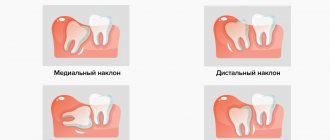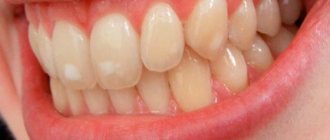Author of the article:
Soldatova Lyudmila Nikolaevna
Candidate of Medical Sciences, Professor of the Department of Clinical Dentistry of the St. Petersburg Medical and Social Institute, Chief Physician of the Alfa-Dent Dental Clinic, St. Petersburg
Inflammation of the periosteum (periostitis) is a disease that brings many painful symptoms. As a rule, acute pain and severe swelling immediately bring the patient to the dentist, and rightly so: not only the condition of the oral cavity, but also health in general depends on the timeliness of treatment.
Typical symptoms
Symptoms of inflammation of the periosteum of the tooth are quite pronounced:
- redness and swelling of the gums;
- increasing severe pain radiating to the ear, temple and other areas, depending on the location of the inflammation;
- swelling of the face on one side (cheeks, lips, cheekbones);
- high body temperature;
- symptoms of general intoxication (headache, dizziness, dry mouth, fatigue and weakness, general loss of strength);
- white or gray plaque on the gums;
- change in tooth position, tooth mobility;
- in some cases, the appearance of purulent discharge.
With a prolonged inflammatory process, a fistula can form: pus finds its way into the oral cavity, which is accompanied by the appearance of blood, but the pain and fever temporarily subside. This is due to the fact that the contents stop accumulating in the tissues and begin to flow out, but you should definitely consult a doctor.
Purulent (post-traumatic) periostitis
It usually develops as a result of infection when the periosteum is wounded, the penetration of infection into it from neighboring organs (for example, periostitis of the jaw due to dental caries), as well as by hematogenous route. With metastatic periostitis, the periosteum of any long tubular bone (most often the femur, tibia, humerus) or several bones is usually affected. Purulent periostitis is an obligatory component of acute purulent osteomyelitis. There are cases in which the source of infection cannot be detected.
Purulent periostitis begins with hyperemia of the periosteum, the appearance of serous or fibrinous exudate in it. Then purulent infiltration of the periosteum occurs, and it is easily separated from the bone. The loose inner layer of the periosteum becomes saturated with pus, which then accumulates between the periosteum and the bone, forming a subperiosteal abscess. With a significant spread of the process, the periosteum exfoliates over a significant extent, which can lead to disruption of bone nutrition and its superficial necrosis. Necrosis, involving entire areas of bone or the entire bone, is formed only when pus penetrates into the bone marrow cavities. The inflammatory process may stop in its development (especially if the pus is removed in a timely manner or if it breaks through the skin on its own) or spread to the surrounding soft tissue and bone substance (see Osteitis).
The onset of purulent periostitis is usually acute, with an increase in temperature to 38-39°C, chills and an increase in the number of leukocytes in the blood (up to 10.0-15.0×109 /l). Severe pain is noted in the area of the lesion, and a painful swelling is felt. With continued accumulation of pus, it is usually possible to notice a fluctuation soon; the surrounding soft tissue and skin may be involved in the process. The course of the process in most cases is acute, although cases of a primary protracted, chronic course are noted, especially in weakened patients. Sometimes a blurred clinical picture is observed without high fever and pronounced local phenomena.
There is malignant, or acute periostitis, in which the exudate quickly becomes putrefactive; the swollen, gray-green, dirty-looking periosteum easily tears and disintegrates. In the shortest possible time, the bone loses its periosteum and is enveloped in a layer of pus. After the periosteum breaks through, a purulent or purulent-putrefactive inflammatory process passes like phlegmon to the surrounding soft tissue.
Why does inflammation of the periosteum occur?
There are three ways that pathogenic bacteria enter the periosteum:
- odontogenic factor - dental diseases become the source of inflammation: caries, cysts and granulomas of the tooth root, pulpitis. Bacteria penetrate deep into soft tissues. Quite often, periostitis is observed as a result of a long and complicated process of eruption of “eights”;
- hematogenous factor - infection occurs as a result of bacteria entering the tissues from the bloodstream or lymph flow. As a rule, this happens in connection with ENT diseases, furunculosis of the face, neck, abscesses, etc.;
- traumatic factor - mechanical damage to the periosteum during fractures, impacts, complex tooth extractions leads to inflammation.
Causes
Inflammation of the periosteum after tooth extraction can occur for various reasons. Here are some of them:
- violation of extraction technique,
- injury to bone tissue during dental procedures,
- penetration of infection into the wound,
- improper oral care after tooth extraction.
The likelihood of developing periostitis is higher if the patient has several carious teeth. Also at risk are people with chronic pharyngitis, otitis media, sinusitis, and immunodeficiency conditions.
Types of inflammation
Symptoms of inflammation of the periosteum of the tooth depend on the form of the process. In the acute form, pain and swelling are severe, difficulty swallowing, spreading of swelling to the face and neck, and enlarged lymph nodes may be observed. Acute inflammation occurs over several days.
The chronic form may bother the patient for several months. Symptoms are more moderate; a fistula may appear - an opening through which inflamed tissues get rid of purulent contents.
There are also two types of both acute and chronic inflammation:
- serous - more often provoked by traumatic injury, swelling forms quickly, but the pain is more moderate and tolerable, relief occurs, on average, after 5 days;
- purulent - more dangerous, characterized by severe throbbing pain, severe swelling and redness of soft tissues, and higher body temperature.
In both cases, you should definitely consult a doctor, since the risk of complications is very high.
Serous albuminous periostitis
An inflammatory process in the periosteum with the formation of exudate that accumulates subperiosteally and has the appearance of a serous-mucosal (viscous) fluid rich in albumin. The exudate is surrounded by brown-red granulation tissue. On the outside, the granulation tissue, together with the exudate, is covered with a dense membrane and resembles a cyst, which, when localized on the skull, can simulate a cerebral hernia. The amount of exudate sometimes reaches 2 liters. It is usually located under the periosteum or in the form of a racemose sac in the periosteum itself, and can even accumulate on its outer surface; in the latter case, diffuse edematous swelling of the surrounding soft tissues is observed. If the exudate is under the periosteum, it exfoliates, the bone is exposed and necrosis may occur - cavities filled with granulations are formed, sometimes with small sequesters.
The process is usually localized at the ends of the diaphysis of long tubular bones, most often the femur, less often the bones of the leg, humerus, and ribs; Young men usually get sick. Often P. develops after injury. A painful swelling appears, the body temperature initially rises, but soon becomes normal. When the process is localized in the joint area, a disruption of its function may be observed. At first, the swelling has a dense consistency, but over time it can soften and fluctuate more or less clearly. The course is subacute or chronic.
Features of treatment
Treatment of inflammation of the periosteum of the tooth should only be carried out by a doctor. The specialist chooses tactics depending on the type and form of the disease.
Drug treatment is only advisable if you consult a doctor immediately at the first symptoms of the disease. Therapy includes:
- taking antibiotics prescribed by a specialist: this will stop inflammation and prevent the spread of infection;
- taking anti-inflammatory drugs, painkillers;
- local effect: use of antiseptic rinses, chlorhexidine baths, ointments and gels with an anti-inflammatory effect.
The course of treatment is at least 5-7 days. If relief does not occur, surgical methods are used.
Symptoms and treatment of inflammation of the periosteum of the tooth are individual. In case of advanced inflammation, ineffectiveness of conservative methods and other indications, the doctor performs a tissue opening - periostotomy. It is carried out in several stages:
- anesthesia: local infiltration or conduction anesthesia is sufficient.
- Making an incision in the gum in the projection of the source of inflammation.
- Washing and cleaning tissues.
- Treatment of the wound with antiseptic agents.
- Installation of drainage - a small rubber band in order to prevent premature fusion of the mucous membrane and the re-formation of pus inside.
The drainage is removed by a doctor after a few days; you should not do this yourself. The specialist must make sure that the contents of the inflamed tissue are released and the wound can be allowed to heal. If the incision is small, no stitches will be required.
If the cause of the disease was a damaged tooth, it is treated: restoring its shape using filling materials, filling root canals. Sometimes removal is required; it is performed simultaneously with surgical treatment of periostitis.
Additionally, physiotherapeutic procedures may be recommended. They will speed up inflammation relief and healing. These include UHF, darsonval therapy, infrared radiation, and magnetic therapy. During the healing period, it is advisable to use vitamins and restorative medications.
How to help yourself before visiting a doctor
If the periosteum of the jaw is inflamed, you should forget about such traditional methods as heating: any hot compresses will aggravate the situation. If you open the formation, take antibiotics without a doctor’s prescription, or remove the pus yourself, this can lead to dire consequences.
You can alleviate your condition by doing the following:
- rinse your mouth with a weak saline solution at room temperature or an antiseptic with an analgesic effect;
- apply a cool compress to the cheek on the side of the inflammation;
- Take an over-the-counter pain reliever.
These measures will help relieve pain and slightly reduce swelling, but you should contact a specialist as soon as possible. As an antiseptic rinse, you can use ACTIVE mouthwash. It does not contain alcohol, so there is no risk of burning inflamed tissues, and the chlorhexidine and benzydamine in the composition will help relieve the condition before you see a doctor.
Biomechanics of injury
The main difference between running and walking is the absence of a double support phase (when both legs are on the ground at the same time), as a result of which the body weight falls on one limb when landing, which leads to a sharp increase in the impact load on the leg and the need to increase the activity of the foot stabilizer muscles. That is, muscles that provide not so much power (like the gastrocnemius and soleus muscles), but rather the correct position of the landing and pushing off foot, adaptation to uneven surfaces.
As a result of increased load, the stabilizer muscles become clogged and shortened, just like any muscle after training. And here the second mechanism that causes injury is activated - the distribution of the shock load.
When we land on our foot, the muscles, ligaments and bones absorb and dissipate the shock. If the muscle is elastic and in normal tone, then most of the blow is absorbed by the lengthening of its abdomen (central part), and the tendons and places of attachment to the bone take on the rest of the blow. If the muscles are shortened and not elastic, much more shock load falls on the attachment site.
Stabilizing muscles are not attached to the bone directly, but by being woven into the periosteum (a dense layer of connective tissue that covers the entire bone). When receiving a blow, the muscles seem to pull the periosteum, which leads to its microtrauma and inflammation.
marathon and half marathon training plans and start training today!
Structural disorders of the foot can also increase the shock load on the lower leg muscles, such as an excessively high arch of the foot (Figure 3), which reduces its shock-absorbing ability, and flat-valgus feet, which often lead to hyperpronation (excessive roll of the ankle joint and the foot inwards when landing ) and, consequently, additional load on the tibialis posterior muscle.
Clinical researches
Repeated clinical studies have proven that the two-component mouth rinse ASEPTA ACTIVE more effectively combats the causes of inflammation and bleeding compared to single-component rinses - it reduces inflammation by 41% and reduces bleeding gums by 43%.
Sources:
- The role of anti-inflammatory rinse in the treatment of periodontal diseases (L.Yu. Orekhova, A.A. Leontyev, S.B. Ulitovsky) L.Yu. OREKHOVA, Doctor of Medical Sciences, Prof., Head of Department; A.A. LEONTIEV, dentist; S.B. ULITOVSKY, Doctor of Medical Sciences, Prof. Department of Therapeutic Dentistry of St. Petersburg State Medical University named after. acad. I. P. Pavlova
- The use of drugs from the Asepta line in the complex treatment of inflammatory periodontal diseases (N.V. Berezina E.N. Silantyeva S.M. Krivonos, Kazan State Medical Academy. Kazan.) N.V. BEREZINA, E.N. SILANTIEVA, S.M. KRIVONOS Kazan State Medical Academy
- Report on determining/confirming the preventive properties of commercially produced personal oral hygiene products: Asepta toothpaste used in combination with Asepta mouthwash and Asepta gum balm Head. Department of PFS Doctor of Medical Sciences Professor S.B. Ulitovsky St. Petersburg State Medical University named after Academician I.P. Pavlova. Faculty of Dentistry. Department of Preventive Dentistry.










